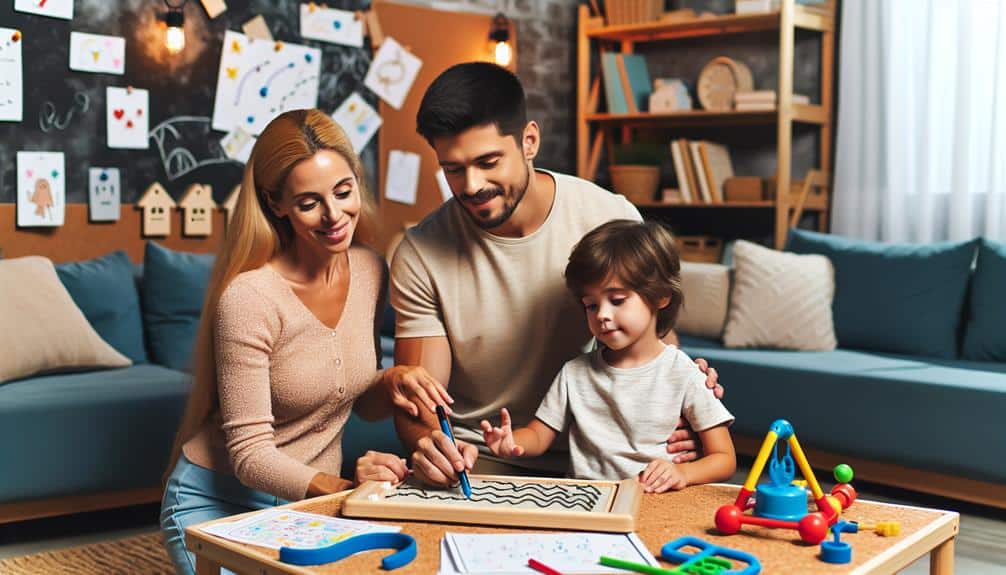To support special needs children through homeschooling, tailor your approach to meet their unique requirements and learning styles. Get involved in their education, create individualized lesson plans, and use adaptive teaching strategies. Establish a nurturing environment with sensory-friendly spaces and emotional support. Foster social skills through interaction and teamwork. Encourage self-care routines and incorporate therapeutic activities tailored to their needs. Track progress and adjust your methods to guarantee a successful homeschooling journey for your special needs child.
Key Points
- Tailor curriculum to unique needs and learning styles.
- Engage parents for vital support and involvement.
- Utilize adaptive materials and assistive technology.
- Implement individualized lesson plans with flexibility.
- Foster a supportive, inclusive learning environment.
Understanding Special Needs Requirements
To effectively support special needs children through homeschooling, it's essential to first understand their unique requirements and learning styles. Parent involvement plays a vital role in identifying these needs and providing necessary support. By working closely with parents, homeschool educators can tailor an inclusive curriculum that caters to the specific challenges and strengths of each child.
Specialized resources are invaluable in meeting the diverse needs of special education students. These resources can include assistive technology, sensory tools, and adaptive materials that facilitate learning in a way that's accessible and engaging.
Additionally, personalized accommodations such as modified assignments, extended time for tasks, or alternative assessment methods can help special needs children thrive academically.
Implementing Individualized Lesson Plans
You can create tailored learning approaches that cater to your child's unique needs, ensuring they receive the support necessary to thrive academically.
By implementing flexible teaching strategies, you can adapt lesson plans in real-time to accommodate your child's learning pace and style.
Individualized lesson plans foster a supportive environment where your child can excel and reach their full potential.
Tailored Learning Approaches
When tailoring learning approaches for special needs children, it's essential to create individualized lesson plans that address their unique strengths and challenges. Personalized instruction is key in catering to their specific needs.
By customizing the curriculum to suit their learning style and incorporating interactive learning methods, you can create a more engaging and effective learning environment. Hands-on activities play a vital role in helping special needs children grasp concepts and retain information.
When designing individualized lesson plans, consider breaking down tasks into smaller, manageable steps to avoid overwhelming the child. Offer varied activities to cater to different learning preferences—visual, auditory, kinesthetic.
Incorporating multi-sensory experiences can enhance their understanding and retention of information. Remember to provide ample positive reinforcement and encouragement during the learning process.
Flexible Teaching Strategies
Crafting tailored lesson plans that accommodate the unique strengths and challenges of special needs children involves implementing flexible teaching strategies that cater to their individual learning needs.
When creating personalized curriculum and accommodating schedules, remember to:
- Personalized Curriculum: Develop lesson plans that align with your child's specific learning goals and interests, ensuring they stay engaged and motivated.
- Accommodating Schedules: Adjust the timing and duration of lessons to suit your child's peak focus hours and energy levels, making learning more effective.
- Varied Activities: Incorporate a mix of hands-on activities, visual aids, and interactive projects to cater to different learning styles and keep lessons dynamic.
- Differentiated Instruction: Modify teaching techniques and materials to match your child's pace and abilities, providing the necessary support and challenges for optimal growth.
Utilizing Adaptive Teaching Strategies
Implementing personalized teaching techniques is essential when supporting special needs children through homeschooling, ensuring their unique learning styles are accommodated effectively.
For sensory accommodations, consider creating a calm, clutter-free workspace with good lighting and minimal distractions. Use noise-canceling headphones or fidget toys to help children stay focused.
Interactive learning activities, such as educational games or hands-on experiments, can make lessons more engaging and memorable.
Tailor your teaching approach to your child's specific needs. If they struggle with reading, try audiobooks or visual aids. Break down tasks into smaller steps and provide plenty of positive reinforcement. Utilize technology like educational apps or online resources designed for special needs students.
Remember to be patient and flexible; progress may be gradual but every small achievement is significant.
Regularly communicate with your child to understand what methods work best for them. Stay open to trying new strategies and adjusting your approach as needed.
Creating a Supportive Learning Environment
To create a supportive learning environment for your special needs child, consider setting up sensory-friendly learning spaces tailored to their needs.
Develop individualized lesson plans that cater to their unique strengths and challenges, ensuring they can learn at their own pace.
Implement emotional support strategies to help them navigate any frustrations or anxieties that may arise during their homeschooling journey.
Sensory-Friendly Learning Spaces
Create a calming and organized space that caters to your child's sensory needs for an ideal learning environment at home. To guarantee your child thrives in this sensory-friendly learning space, consider implementing the following:
- Sensory Friendly Decor: Choose decor elements that are soothing and not overly stimulating. Soft lighting, comfortable seating, and minimal visual clutter can create a peaceful atmosphere conducive to learning.
- Learning Space Organization: Keep the learning area clutter-free and well-organized. Utilize storage solutions like bins, shelves, and baskets to neatly store materials and minimize distractions.
- Personalized Sensory Stations: Establish different sensory stations within the learning space tailored to your child's needs. For example, a quiet corner with noise-canceling headphones or a fidget toy station can provide sensory support during learning activities.
- Flexibility in Design: Be open to adjusting the learning space based on your child's feedback and evolving sensory requirements. A flexible environment allows for changes that cater to your child's comfort and focus levels.
Individualized Lesson Plans
Designing personalized lesson plans tailored to your special needs child's unique strengths and challenges can foster a supportive and effective learning environment at home. By creating a personalized curriculum, you can cater to your child's specific educational needs. This approach allows for specialized instruction that aligns with their learning pace and preferences. Educational accommodations play an essential role in ensuring that your child can fully engage with the material.
Understanding your child's unique learning styles is key to crafting lesson plans that resonate with them. When developing individualized lesson plans, consider incorporating activities that appeal to your child's interests and strengths. By adapting the material to suit their learning style, you can enhance their comprehension and retention of the content.
Remember to be flexible and open to adjusting the lesson plans as needed to accommodate any challenges your child may encounter. Embracing a personalized approach to teaching can create a nurturing and supportive learning environment where your special needs child can thrive.
Emotional Support Strategies
Establishing a safe and nurturing atmosphere at home will help your special needs child feel supported and ready to learn. Here are some strategies to provide emotional support for your child:
- Positive Reinforcement: Celebrate small victories and progress made by your child. Encouragement and praise can boost their confidence and motivation.
- Teaching Coping Skills: Help your child develop effective coping mechanisms to manage emotions and navigate challenging situations. This can empower them to handle stressors more effectively.
- Fostering Social Skills: Create opportunities for your child to interact with peers, siblings, or other family members. Building social skills can enhance their communication and relationship-building abilities.
- Establishing Self-Care Routines: Encourage self-care practices like mindfulness exercises, relaxation techniques, or engaging in hobbies they enjoy. These routines can promote emotional well-being and help them manage anxiety or overwhelm effectively.
Incorporating Therapeutic Activities
Enhancing your child's homeschooling experience may involve integrating therapeutic activities tailored to their specific needs and interests. For children with special needs, incorporating sensory integration activities can help regulate their responses to stimuli and improve focus. Consider setting up a sensory-friendly space with items like fidget toys, weighted blankets, or noise-canceling headphones to create a calming environment for learning.
Play therapy can also be a beneficial therapeutic activity to include in your homeschooling routine. Through play, children can express themselves, build social skills, and work through emotional challenges in a safe and enjoyable way. Encourage imaginative play, storytelling, or board games that promote cooperation and communication.
When planning therapeutic activities, remember to observe your child's responses and adjust accordingly to meet their evolving needs.
Tracking Progress and Adjusting Approaches
To effectively support your special needs child through homeschooling, consistently monitoring progress and adjusting your approaches is essential. Here are some tips to help you track progress and adapt your methods effectively:
- Celebrating achievements: Recognize and celebrate even the smallest victories your child accomplishes. This positive reinforcement can boost their confidence and motivation.
- Evaluating challenges: Regularly assess the challenges your child faces. Understanding their struggles will help you tailor your homeschooling approach to address these difficulties effectively.
- Customizing curriculum: Modify the curriculum to suit your child's learning style and pace. Tailoring the material can make learning more engaging and accessible for them.
- Adapting techniques: Be open to trying new teaching methods and techniques. Flexibility in your approach can help you discover what works best for your child and make learning more effective and enjoyable for them.
Frequently Asked Questions
How Can Homeschooling Help With Social Skills Development for Special Needs Children?
Imagine homeschooling as a bustling social hub for your child! Through daily interactions, games, and group projects, you'll witness remarkable growth in social skills, communication, peer relationships, and emotional intelligence—all fostered within a supportive environment.
What Resources Are Available for Homeschooling Special Needs Children?
When homeschooling special needs children, support groups provide valuable connections. Therapies can be tailored to your child's needs. Utilize adaptive materials and assistive technology to enhance learning. These resources offer personalized solutions for your family.
Are There Specific Homeschooling Curriculums Tailored for Special Needs Students?
Yes, there are homeschooling curriculums specifically designed for special needs students. These curriculums offer individualized instruction, adaptive materials, differentiated learning activities, and modified assessments to cater to the unique needs of each student, ensuring a supportive and effective learning experience.
How Can Parents Connect With Other Homeschooling Families With Special Needs Children?
To connect with other homeschooling families with special needs children, you can find parent support through online groups and network at community events. Share experiences, resources, and build a strong support system together.
What Legal Requirements Should Be Considered When Homeschooling Special Needs Children?
When homeschooling special needs children, it's essential to understand the legal requirements. Parental rights are paramount, ensuring you have the authority to make educational decisions. Seek educational accommodations to support your child's unique learning needs effectively.



